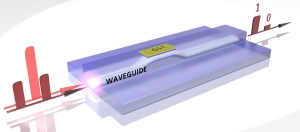A team of researchers from Karlsruhe Institute of Technology (KIT) and the universities of Münster, Oxford, and Exeter have created the first non-volatile, all-optical on-chip memory using phase change materials.
 All-optical data memory: Ultra-short light pulses make the GST material change from crystalline to amorphous and back. Weak light pulses read out the data. (Photo: C. Rios/Oxford University)
All-optical data memory: Ultra-short light pulses make the GST material change from crystalline to amorphous and back. Weak light pulses read out the data. (Photo: C. Rios/Oxford University)
Phase change materials possess the ability to modify their optical properties based on their atom arrangement. This allows storage of a number of bits in a single cell.
This research work is a crucial step in the progress towards optical computers. A paper describing the research was published in Nature Photonics journal.
It is a fact that light is going to play a huge role in the future of information and communication technology. Optical elements are going to enable computers to work faster and efficiently than ever before. For years, optical fibers have been used to transmit data using light. However, processing and storing of data are only performed electronically on a computer.
The speed of the advanced computers is hindered because of the electronic transmission of data between processors and the memory. This hurdle is referred as the von Neumann bottleneck, and cannot be solved by simply connecting the memory and processor optically, as the optical signals will then have to be converted back into electric signals. Therefore, researchers are constantly seeking to find techniques to perform calculations and data storage optically.
“Optical bits can be written at frequencies of up to a gigahertz. This allows for extremely quick data storage by our all-photonic memory,” Professor Wolfram Pernice explains. At KIT Institute of Nanotechnology (INT), Pernice led a working group before moving to the University of Münster. “The memory is compatible not only with conventional optical fiber data transmission, but also with latest processors,” Professor Harish Bhaskaran of Oxford University adds.
The novel memory created by the collaborative team is capable of storing data for many years even if the power is cut. Furthermore, it can store many bits in a single cell of a billionth of a meter in size.
Rather than the data values of 0 and 1, it is possible for multiple states to be stored in an element, and for autonomous calculations to be performed. This is because of the phase change materials that are used. These materials can switch between crystalline and amorphous states in the least amount of time.
The researchers used the phase change material Ge2Sb2Te5 (GST) for the memory. Triggered by ultra-short light pulses, the material switches from crystalline to amorphous state for data storage, and from amorphous to crystalline state for data deletion. Weak light pulses are applied to read out the stored data.
Going forward, it is likely that permanent all-optical on-chip memories may impact the performance of computers and minimize their energy consumption. Also, along with all-optical connections, latencies can be decreased.
This research could put an end to the need for converting optical signals into electronic signals and vice versa using huge amounts of energy.